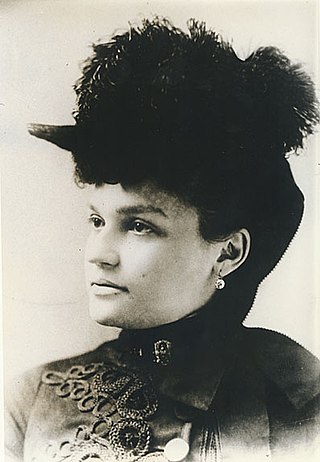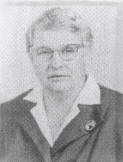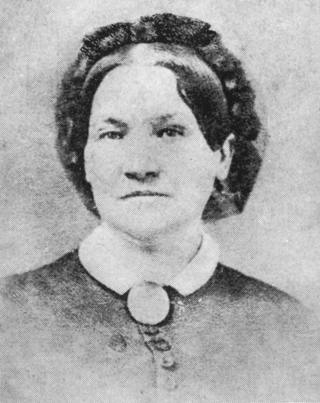
Belle Brezing was a nationally known madam in Lexington, Kentucky at the end of the 19th century and into the beginning of the 20th. Her brothel was known as the "most orderly of disorderly houses".

Reine Davies was an American singer and actress.

Zerelda Elizabeth Cole James Simms Samuel was the mother of famous outlaws Frank James and Jesse James.

Madeline (Madge) McDowell Breckinridge was an American leader of the women's suffrage movement in Kentucky. She married Desha Breckinridge, editor of the Lexington Herald, which advocated women's rights, and she lived to see the women of Kentucky vote for the first time in the presidential election of 1920. She also initiated progressive reforms for compulsory school attendance and child labor. She founded many civic organizations, notably the Kentucky Association for the Prevention and Treatment of Tuberculosis, an affliction from which she had personally suffered. She led efforts to implement model schools for children and adults, parks and recreation facilities, and manual training programs.

Old Fort Harrod State Park is a park located in Harrodsburg, Kentucky in the United States. The park encompasses 15 acres (6.1 ha) and features a reconstruction of Fort Harrod, the first permanent American settlement in the state of Kentucky. The park was founded in November 1934 as Pioneer Memorial State Park, and dedicated by President Franklin D. Roosevelt and Governor Ruby Laffoon.

William Henry Hatch was a U.S. Representative from Missouri. He was the namesake of the Hatch Act of 1887, which established state agricultural experiment stations for the land-grant colleges. Hatch is also the namesake of Hatch Hall, a Residence Hall at the University of Missouri.

Maria Thompson Daviess was an American artist and feminist author. She is best known for her popular novels written in the early 20th century, with a "Pollyanna" outlook, as well as several short stories, among them, “Miss Selina Sue and the Soap-Box Babies," "Sue Saunders of Saunders Ridge" and "Some Juniors.". Daviess was affiliated with the Equal Suffrage League in Kentucky, being the co-founder and vice-president of the chapter in Nashville and an organizer of the chapter in Madison.

Georgina Pope Yeatman was an American architect. In 1936, she became the first woman to serve as the director of architecture for the city of Philadelphia, Pennsylvania, which, at that time, was the third largest city in the United States.
Donna Moore (1931-2014) was an American Saddlebred horse trainer. She trained horses for William Shatner at his Belle Reve Farm, and owned her own stables near Versailles, Kentucky.

Marguerite Martyn was an American journalist and political cartoonist with the St. Louis Post-Dispatch in the early 20th century. She was noted as much for her published sketches as for her articles.

Elsie Hopestill "Hope" Butler Wilson was an American ambulance driver and canteen operator in France and Serbia during World War I. She organized a unit of women volunteer ambulance drivers with Marguerite Standish Cockett.

Vine Colby McCasland was an American essayist and poet for The Potters artistic group in St. Louis, Missouri, in the early 20th century. After the Potters disbanded, she became a journalist and writer of short stories, and engaged in a career of sociological and economy study.

Frances Porcher (1853–1935) was an American writer and journalist.

Zoe Anderson Norris was a Kentucky-born journalist, novelist, short story writer and publisher, known for her bimonthly magazine, The East Side (1909–1914), which focused on impoverished immigrants in New York. She also contributed to publications including The New York Times, New York Sun, Frank Leslie's Monthly, Harper's Weekly and Argosy. She investigated journalistic topics including corrupt charity executives and child abuse cases. Her fiction plots often centered around starving artists, women deceived by hypocritical suitors and farmers battling the elements. She founded the Ragged Edge Klub, a group of writers, filmmakers, politicians and performers who met for weekly dinners. She was considered "one of the most popular writers of newspaper sketches in the country" and known as a Queen of Bohemia. An exhibition, To Fight for the Poor With My Pen: Zoe Anderson Norris, Queen of Bohemia, ran March 1-May 13, 2023, at the Grolier Club museum in New York.

David Glenn was of Irish descent and was born in 1753, likely in Pennsylvania but possibly in Virginia. He was one of the early settlers of Kentucky having accompanied James Harrod in founding Harrodstown in 1774, along with his older brother, Thomas. Today, Harrodsburg is considered the oldest permanent white settlement in Kentucky, being it was settled almost a full year before Boonesborough.
Jane T. H. Cross was an American author. She was, for some years, an occasional contributor of prose and poetry to the religious journals of the South. She wrote a series of stories for children, which were collected and edited by Dr. Summers, and published in four small volumes, called, Wayside Flowerets, Heart Blossoms for My Little Daughters, Bible Gleanings, and Driftwood. Gonzalo de Cordova was a translation from the Spanish; Duncan Adair, was a novel; and Azile, was a story partly of Southern experiences during the American Civil War. Upon her return from Europe, her letters from abroad were collected and published.

Florence Anderson Clark was an American author, newspaper editor, librarian, and university administrator. She served for 14 years as assistant librarian at the University of Texas (UT), and in honor for her service to the university, she was first woman to have her portrait hung in the university's Main Tower. Clark was affiliated with several organizations, including the Daughters of the American Revolution (D.A.R), Colonial Dames of America, and United Daughters of the Confederacy.

Maria T. Daviess was a 19th-century American author of Kentucky. Among her publications were Roger Sherman, a Tale of '76; Woman's Love; a volume of Poems; and History of Mercer and Boyle Counties.

Rosa Kershaw Walker was an American author, journalist, and newspaper editor of the long nineteenth century. She was one of the best-known literary women in St. Louis, Missouri, and a pioneer woman journalist of that city.

Maria I. Johnston was an American author, journalist, editor and lecturer. She wrote many stories, long and short. In her stories, she dealt for the most part with life in the West and South, the conditions caused by war and slavery being considered. She was the author of The Siege of Vicksburg, The Freedwoman, Jane, Hector, Oh, Come with Me to the West, Love, Miss Emily's Glove, Ante-Bellum, and The Story of a Confederate Colonel. Johnston was active with newspaper work and was identified with newspapers in St. Louis, New Orleans, Vicksburg, and Memphis. At times, she wrote under the nom de plumes of "Paul Pry" and "Neal Caxton". She was advocate of and writer for woman suffrage.


















